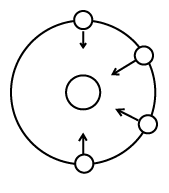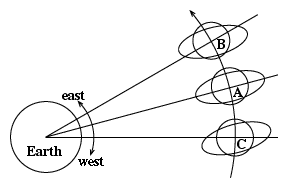Geometrical Librations
Just as the rotation axis of the Earth is inclined by (90°–23.5°) to the Earth-Sun direction (drawing above, from section #3 "Seasons of the year"), so the rotation axis of the Moon is inclined by about (90°–6.5°) to the mean Moon-Earth line. As noted, that line is also the direction of the Moon's elongation, on the average always pointed towards Earth.
In the discussion of the seasons of the year, it was shown how the 23.5° tilt of the Earth axis lets the Sun shine onto the polar caps, onto circular areas around the poles, giving them 24-hour sunlight. The drawing demonstrates how in June the Sun illuminates the northern polar cap and in December (when shade and light are interchanged) the southern one.
Similarly, each lunar orbit, the tilt of the Moon's rotation axis allows observers on Earth to peek into the polar regions of the Moon--at some time into the northern one, half a month later into the southern one. Because the tilt is much smaller (only 6.5°), the area thus revealed is much smaller, but still, this increases coverage.
-
Suppose the moon moved with steady speed in a perfectly circular orbit around Earth, and also rotated at a steady rate around its axis. That ideal situation is shown below in a drawing, taken from section #4 ("The Moon--a distant view"). This is the view from north, so the Moon's orbital motion starts from the bottom and advances counter-clockwise, and the Moon itself also rotates counter-clockwise.
Then--neglecting the 6.5° tilt discussed in item #1 above--the axis of the Moon could always point straight at the Earth, always exposing the same range of longitudes on the Moon's surface. As the figure shows, during the time the Moon covers 60° in its orbit, its body has also rotated by 60°. In the time it covers 120°, it has also rotated by 120°, and so forth. The same axis of the Moon always points at Earth, and by the time the Moon-Earth line has rotated a full 360° in the plane of the drawing (the orbital plane of the Moon), the Moon itself has also rotated a full 360°.

Now imagine that the Moon orbited at a steady speed, but the rotation of the Moon around its axis varied--sometimes it speeded up, sometimes it slowed down, though on the average it still matched the orbital period. Then when the rotation was a bit ahead of the Moon,Earth line, observers would see a little extra of the receding edge of the Moon. And when the rotation lagged a bit behind, astronomers could see a bit more of the advancing edge.
No, this does not happen. The rotation rate of the Moon is pretty steady. However, the orbiting motion of the Moon is not steady--at some times it advances faster than average, some times it is slower. The result is pretty similar to the above example of uneven rotation, and that is a second kind of libration. The first one lets astronomers peek over the poles, while this one adds to the longitudes visible to Earth-based telescopes.
Below are the details, which you can skip if this is heavy going for you. The actual orbit of the Moon around Earth is not a circle but an ellipse, an oval shape (in this case, one not greatly different from a circle), in agreement with Kepler's first law of planetary motion (section #10),). Its distance from Earth, therefore, goes up and down slightly. And by Kepler's 2nd law (section #12), the Moon speeds up when closer to Earth, and slows down when further away.
When it speeds up, the rotation of the Moon-Earth line around the Earth (measured in degrees per hour) is faster. The rotation of the Moon around its axis, as noted, stays steady, and therefore lags behind that rotation. In the drawing below, the elliptical shape of the Moon is very much exaggerated, to make clear the argument below.

If (as in the preceding drawing) the Moon orbited the Earth at the same rate as its body rotated around its axis, the Earth-Moon line and the long axis of the Moon would match, as in position "A" in the diagram. Actually, if this is the part of the orbit closest to Earth, with the moon advancing fastest, it would already have raced ahead to position "B"--although its rotation at the same time would still be the one appropriate to "A."
If that happened, the long axis of the Moon would make a small angle with the Earth-Moon line (as drawn), allowing astronomers to peek past the western edge of the visible Moon ("east" and "west" are defined with respect to Earth, so the western edge is the one closer to the western horizon of the observer.)
Similarly, when the motion of the Moon is extra-slow, by the time the rotation of the Moon brings it to the orientation in position "A", the orbital motion has only managed to reach position "C." Now an extra little sliver near the eastern edge becomes visible. While the first type of libration adds to our coverage near the poles of the Moon, this type increases coverage at the east and west edges, by about 7.7 degrees (out of 360).
-
A third "libration" arises because the size of the Earth is not negligible. During the 12 hours or so when the Moon is visible on any day, the rotation of the Earth can displace an observer by up to one diameter of the Earth (for observers on the equator), shifting the line of view and slightly increasing the observable area. Similarly, observers in the northern and the southern hemisphere get slightly different views. Since this effect again allows astronomers to "peek past the edge," it too is counted as a sort of libration. At a lunar distance of 60 RE (Earth radii), a displacement of 1 RE shifts the viewing angle by about 1°.
Physical Librations
In addition to the preceding modes, there also exist "physical" librations, actual pendulum-like nodding and wobbling of the Moon around its equilibrium position, like the spring-attached head of one of those "bobblehead dolls" popular as souvenirs.
The main mode is pole-to-pole nodding and amounts to about a degree and a half. The longitudinal side-to-side oscillation, on the other hand, has an amplitude of only a quarter of a minute of arc, much too small to be measured by ordinary telescope-based methods. It can however be quite easily checked by laser signals bounced back from the sets of reflecting prisms left by Apollo 11, 14 and 15 astronauts on the Moon, part of the ALSEP or "Apollo Lunar Surface Experiment Package," or by the set placed there by the Soviet Luna 21 robot lander. The results are in agreement with the theory of such motions, which was extended to cover motions previously neglected as unobservable.
Other cases of locked-in rotation
Moons whose rotation is "locked in" or "synchronous"--always presenting the same face to the parent body--are surprisingly common in the solar system, especially inner moons, close to the planet. All four "Galilean satellites" of Jupiter are synchronous: volcanic Io, Europa, Ganymede and Callisto, all discovered by Galileo. The 5 inner moons of Saturn are similarly synchronous, as is Iapetus, more distant, the mysterious half-dark-half-light moon which in Arthur Clarke's book "2001, Space Odyssey" was the gateway to another world.
The rotation of the planet Mercury is locked onto the Sun in a strange way--three rotations every two orbits. And the strange rotation of Venus, from east to west, unlike Earth--seems to be locked on Earth. The lock seems imperfect and may be accidental, but the fact is that every time Venus is closest to Earth, it presents us with almost exactly the same face. Venus is covered by dense clouds, and the radar-carrying Magellan mission has mapped almost all of its surface in great detail. Before that, though, the main tool for studying the surface were radio telescopes, doubling as radar dishes for bouncing signals off the planet. Only imperfect images could be obtained, but astronomers were frustrated to find that on every closest approach, the same face presented itself.
---------------
References
"The Moon" by Zdenek Kopal, Academic Press 1960, 1964
"The Motion of the Moon" by Alan Cook, Adam Hilger 1988,
|